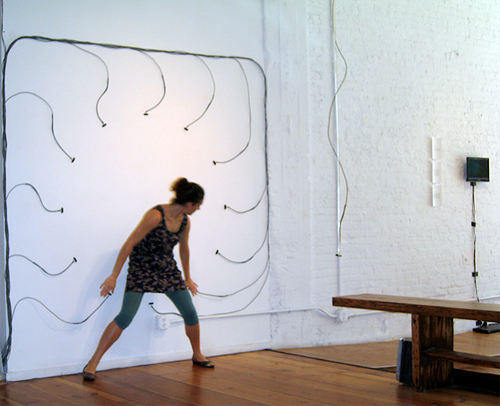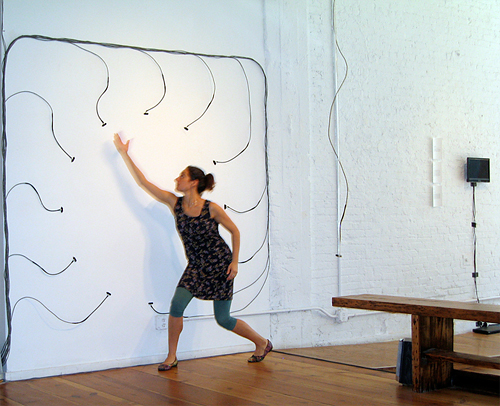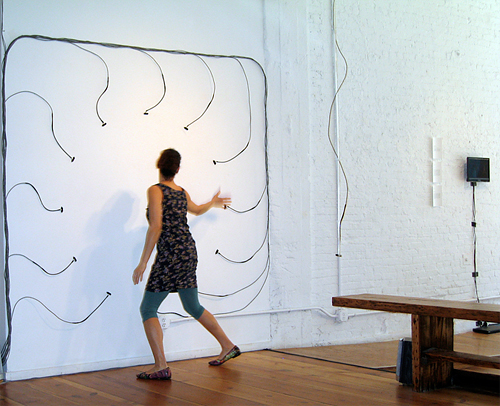Space Shifter / Rhythm Machine 2.0 at
a site-specific interactive sound installation by Nina Waisman
La Mama Galleria / Culturehub, NY, NY; 2011
Video documentation, quick take:
Sara Galassini tries it out
filmed by Billy Clark
Description
"It is possible, almost without commentary, to oppose the rationality of the roof to the irrationality of the cellar". Space Shifter / Rhythm Machine mashes-up Gaston Bachelard's metaphor with Ray Bradbury's story The Veldt, in which parents provide their children with a high-tech nursery. This nursery can become any place the kids imagine - sonically, aromatically, visually manifesting their imaginations, dissolving the built boundaries of the playroom. Space Shifter combines the sonic potential of these 2 ideas: vertical progression as metaphor for a mind, moving from the irrational to the seemingly rational, plus a Bradbury-esque virtual space, whose qualities shift w/the interests of those inside it.
When visitors place body parts in front of the sensors that make up this circular portal, they trigger sound. Databases of sounds lie behind each sensor; moving towards or away from the sensors increases or decreases speed, pitch, volume. Thus the sound-scape is always different, composed in collaborations between the visitor and the piece. Triggering multiple sensors can evoke a children's play-space, a lover's rendezvous, a sweat-shop, or an indeterminate mash-up. Concrete sounds shape-shift, rhythmic mindscapes are created and modulated by visitors bodily actions.
The lower part of the body triggers actual sounds one might hear in a basement - mice, cats, dripping water, a radiator, etc. Near the 3 0'clock and 9'oclock positions, i.e. at the level of the hands and shoulders, are sounds of mundane human work and play behaviors. And then clustered around the head, i.e. around the 12 o'clock position, are the sounds of our machines - a reach for the seemingly ultra-rational - which results in sounds, experiences and conventions that are the most irrational of all. These sounds are interpreted, misinterpreted, manipulated by and manipulative of listeners. Sound and gesture impact brains in ways we are not always aware of, and cannot precisely articulate.
For example, neurologists have found that hearing the sound of another body performing an action can lead us to experience this same action in the brain and muscles. We don’t enact the gesture but nerve-clusters for producing the action fire, and muscles are primed to act. Neurologists link this mirroring system to a survival-driven need for empathic skills – when I hear you do something, I experience your state, and can sense viscerally how we might next interact. In Space Shifter , most of the sounds heard are sounds made by other bodies gesturing and acting in ways often familiar to the user.
Adding to gesture's potential role in our thinking, Rodolfo Llinas (NYU Neurosciences Chair) explains that our learned gestural skills - walking, typing, etc - play in our brains, even when we don’t move. Not all play at once, but a few play together at a time, randomly. Llinas’ research finds that the overlaying of these gestural tapes is the source of creative thought! New logics arise from interference between re-played memories of our motor-based actions. A new tech-gesture, then, is not a small thing.
Thus hearing sounds of recorded bodies performing actions can lead listeners to "mirror" the heard gestures. These mirrored gestures, overlaid with whatever gestural tapes are already playing in a listener’s brain, can lead to new, "creative" or affiliated logics. Adding to this common, gestural pile-up, visitors to this installation employ new tech-controlling gestures to manipulate gestural sounds heard in the space.
This logic-building, gesturally mashed-up medium is worth considering, given the increasing presence of physical computing devices and mediated sound in our everyday lives....

Sara Galassini in the piece. photo:

Sara Galassini in the piece. photo:

Sara Galassini in the piece. photo: